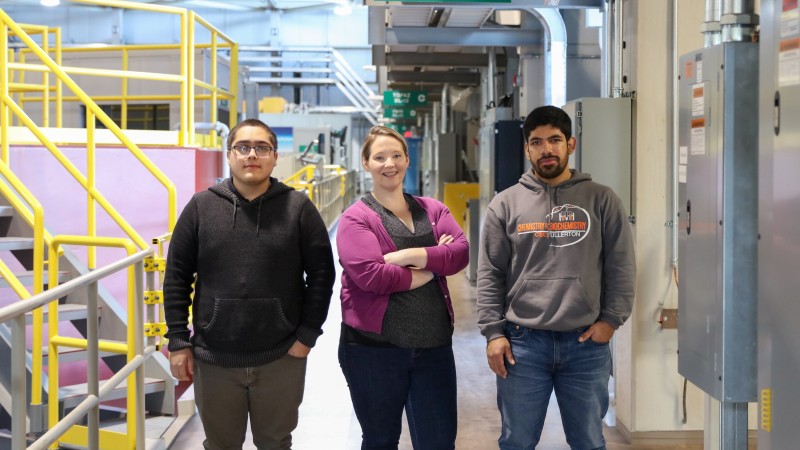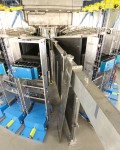Since graduate school, chemist and now-professor Ally Fry-Petit has traveled to the US Department of Energy’s Oak Ridge National Laboratory (ORNL) in Tennessee to examine interesting solid-state materials using the POWGEN powder diffractometer at ORNL’s Spallation Neutron Source (SNS).
“POWGEN is one of the best diffractometers in the world,” said Fry-Petit, who serves on the executive committee of the SNS-High Flux Isotope Reactor User Group. They represent several thousand scientists who use ORNL’s large-scale neutron facilities.
Indeed, POWGEN is a versatile instrument capable of quickly collecting neutron diffraction data in situ—that is, capable of capturing structural dynamics and physical changes as they occur. POWGEN is one of 18 instruments at SNS, with an additional one under construction, where materials are bombarded with intense pulses of neutrons to reveal new information about their structures and characteristics.
Professor of analytical and materials chemistry at California State University, Fullerton (CSUF), Fry-Petit recently returned to SNS in December with two undergraduate students from her CSUF materials chemistry research lab so they could gain first-hand experience with neutron diffraction and be introduced to a potential career path at a National Lab like ORNL.
“I’m passionate about bringing undergraduate students because I don’t think I was aware of research facilities like this or what they did until I was in graduate school, but there is value in seeing this as a career path now while students are stilling choosing what they will do,” Fry-Petit said.
CSUF senior Daniel Sandoval and junior Jose Gonzalez Jimenez are both majoring in chemistry and studying in Fry-Petit’s lab, where they learn how to design functional materials by collecting and analyzing instrumental data. One lab objective is to learn how to conduct quantitative analysis of a material’s chemical components.
Sandoval said it was while performing quantitative data analysis with Fry-Petit that he first heard about neutrons: “Ally told me the data was made by bombarding the sample with neutrons.”
Although students have access to x-ray diffraction, spectrometers, calorimetry, and other instrumental techniques at CSUF, Fry-Petit said, “Neutron scattering is not something a lot of chemists get to see in undergrad.”
Yet these neutrally charged, nondestructive particles are particularly useful for studying lighter weight elements such as oxygen. As it turns out, oxygen is an important element to the CSUF team’s research as they observe oxygen transport in solid oxide materials.
Their research is funded by the American Chemical Society Petroleum Research Fund for its potential applications. “The process of petroleum refining requires a lot of oxygen, but to take that oxygen from the air is difficult and expensive,” Fry-Petit said. “At POWGEN, we drive oxygen out of the system while collecting diffraction patterns to see how it leaves and how the structure of the oxide changes when it returns.”
During the trip to ORNL, Sandoval and Gonzalez Jimenez contributed to the experimental process from beginning to end. First, they met with POWGEN instrument scientist Chang Li to discuss how they would set up the experiment.
“Now we know how the instruments get neutrons from the proton source,” said Gonzalez Jimenez, who prepared for the trip by learning how to perform Rietveld refinements, a technique used with neutron diffraction patterns to characterize crystal structures.
Sandoval and Gonzalez Jimenez assisted Fry-Petit with preparing the samples by combining the metal precursors to form a gel and heating it at high temperatures until the organic components burned away, leaving only metal and oxygen.
“Oxygen transport creates interesting dynamics in solids,” Fry-Petit said. “It’s easy to think of solids as static, but there is dynamism to solids that affects how we can use them.”
Once all the neutron diffraction data was collected over the course of a couple of days, Sandoval and Gonzalez Jimenez returned to CSUF where they will analyze the large amount data with other students in Fry-Petit’s lab.
In the near future, the team plans to use their POWGEN results and data analysis to write a paper and apply for more beamtime to continue neutron experiments.
A long-term goal of their research is to contribute to material developments that efficiently transport oxygen for petroleum refining, although the basic research has applications for ionic conductors and other solid-state materials as well.
For Sandoval and Gonzalez Jimenez, yet another goal is to consider how research at large-scale facilities like SNS might factor into their future careers. “I have the big picture, but I still need to figure out the details,” Gonzalez Jimenez said. “I think maybe one day I would like to run my own research lab.” Sandoval said he still has not decided if he would like to immediately apply his chemistry degree to a career in industry or go to graduate school.
As for Fry-Petit, she said she hopes the hands-on research experience shows the students in her lab a side of science beyond the instructional—as an innovative and ever-changing endeavor.
“Research at a place like SNS shows them that we’re still developing new ways to study science,” she said. “It’s easy for students to get the impression that we’ve invented all of the equipment and now we’ve just got to use it, but we’re constantly updating our instruments.”
The Spallation Neutron Source is a DOE Office of Science User Facility. UT-Battelle LLC manages ORNL for DOE’s Office of Science. The Office of Science is the single largest supporter of basic research in the physical sciences in the United States and is working to address some of the most pressing challenges of our time. For more information, visit https://energy.gov/science. —by Katie Jones





